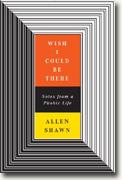Wish I Could Be There
Allen Shawn
book reviews:
· general fiction
· chick lit/romance
· sci-fi/fantasy
· graphic novels
· nonfiction
· audio books
· author interviews
· children's books @
curledupkids.com
· DVD reviews @
curledupdvd.com
newsletter
win books
buy online
links
home
for authors
& publishers
for reviewers

 |
Wish I Could Be There: Notes From a Phobic Life Allen Shawn Viking Hardcover 288 pages February 2007 |
|
Perhaps it’s easiest to empathize with those who have phobias by imagining common fears most of us have suffered at some point in life - stage fright, speaking in front of a group, interviewing for a job – but re-imagining those experiences as having been so magnified and intense as to be near-paralyzing and emotionally shattering. “Like pain, fear is a sign; a sign that something is wrong,” says author Allen Shawn; “A phobia is like a pain in the soul.”
He has coped while continuing to challenge himself by traveling, over the years, via train, transatlantic ship, and car. For this, though, he pays a price: “In each case I am almost frozen with anticipatory anxiety for weeks or months in advance and am exhausted, if pleased, afterwards.” Still, the power of his phobias sometimes prevail, and he is forced to opt out of an activity because of “a habitual response as concrete as arthritis or an allergy.” Yet, unlike arthritis or allergy, phobias may bear a double stigma, equating in the view of some to weak will and flawed character. He explains, though, that two sorts of anxiety – realistic anxiety and phobia, which also is called neurotic anxiety – can co-exist in any individual. Thus, he says, “phobics often react well in a real crisis.” He gives a personal example of fiercely resisting an attack by three muggers attempting to pin him down and rob him in the cramped vestibule of his New York apartment building. A neighbor’s yelling caused the thugs to scatter; later Shawn analyzed his reaction to the assault. “Then I realized that what had made me summon up all my strength in the vestibule was... that I was being held down. My lifelong claustrophobia had awakened in me an intensity of physical response that the realistic danger of being harmed might not have.” One theory of phobias - a “persistent and irrational fear of any specific object, activity, or situation that results in a compelling desire to avoid the feared or phobic stimulus” – is that they are genetically based. This would seem to fit the author’s case because his late father, William Shawn, editor of The New Yorker magazine for 35 years, suffered from them, as did an uncle, aunt, and paternal grandmother. Yet the riddle of cause (genes? upbringing? imitating a phobic parent?) remains unsolved, having challenged even Sigmund Freud. However, two details of Shawn family history seem to loom as possible contributing factors to the condition:
Of his father, he has concluded, “Overall I believe that the tensions and paradoxes of his nature were rather successfully balanced...Still, I can’t help thinking that there was something deeply unresolved in his nature that confronted him when he was isolated, trapped, or far from the familiar.” In spite of the hampering effects of their phobias, father and son managed complicated careers – the senior Shawn at the helm of one of the nation’s most influential literary magazines and his son in music as pianist, composer, and teacher. The author’s older brother, Wallace Shawn, is a playwright and actor. He intended, he says, that the book have a focus even beyond the subject of phobias - in order to include, for example, references to common quirks of personality and flaws inherent in humans. “If they didn’t cause so much suffering,” he believes, “we could come to appreciate these strange revulsions as touching evidence of the human imagination, like dreams, spontaneous projections from our inner selves.” Allen Shawn also wrote Arnold Schoenberg’s Journey. Originally published on Curled Up With A Good Book at www.curledup.com. © Norma J. Shattuck, 2007 |
|
|
|
 Click here to learn more about this month's sponsor! |
|
| fiction · sf/f · comic books · nonfiction · audio newsletter · free book contest · buy books online review index · links · · authors & publishers reviewers |
|
| site by ELBO Computing Resources, Inc. | |
 Shawn, being both agoraphobic and claustrophobic, lives with a litany of magnified fears most of us will never experience:
of heights, being on the water, crossing bridges, and open spaces such as parking lots and fields. Conversely, his fears of being closed-in make him “petrified of tunnels.” He also avoids elevators, enclosed malls, and buildings with windows that do not open. Still, Shawn approaches his afflictions with what seems an admirable sense of proportion: “It can’t be compared with...life-threatening illness, being caught in a war, being subject to injustice and persecution, or countless other torments that people face all over the world.”
Shawn, being both agoraphobic and claustrophobic, lives with a litany of magnified fears most of us will never experience:
of heights, being on the water, crossing bridges, and open spaces such as parking lots and fields. Conversely, his fears of being closed-in make him “petrified of tunnels.” He also avoids elevators, enclosed malls, and buildings with windows that do not open. Still, Shawn approaches his afflictions with what seems an admirable sense of proportion: “It can’t be compared with...life-threatening illness, being caught in a war, being subject to injustice and persecution, or countless other torments that people face all over the world.”